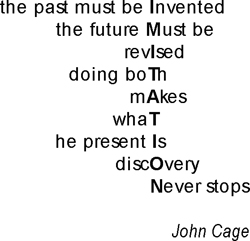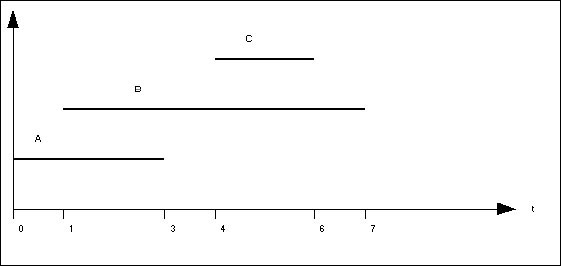(1993-95), triptych for female voice, 8 tracks tape and live computer
Premiered at XLVI Festival Internazionale di Musica Contemporanea, Venezia, Teatro Fondamenta Nuove, July 1995
Voice: Marianne Pousseur
Sound projection: Roberto Doati, Alvise Vidolin
Commissioned by La Biennale di Venezia
“Testa arcaica” [12’] for female voice and live computer
“Pigra giornata” [8’ 52”] for female voice and tape ad libitum
“Forma di nebbia” [19’] for female voice and live computer

L’olio con cui si condiscono le parole is a triptych for female voice and electronics commissioned by La Biennale di Venezia Contemporary Music Festival (1995) and includes “Testa arcaica”, “Pigra giornata” and “Forma di nebbia”.
Among the Ibos the art of conversation is considered very important, and proverbs are the oil with which words are seasoned. Proverbs are archaic remains, archetypes. The oil with which I seasoned the words of Spender, Holiday, von Droste-Hülshoff is my privileged archetype: technology. I have always believed that dedications give luster more to those who make them than to those who receive them. I now contravene this belief of mine in regard to three people who played an important role in the creation of this work. The oil in the title is the painting by Ettore Spalletti, to whom “Pigra giornata” is dedicated. His oil has often seasoned our conversations. To Mario Messinis I dedicate “Forma di nebbia”, with all my gratitude for having given the opportunity to the little oil in my work to come to the surface. But neither words nor oil would exist today without the angelic and sensual voice of Marianne Pousseur, to whom “Testa arcaica” is dedicated. It is with her patience and professionalism that I was able to build the images and emotions of this work that I hope will manifest themselves when listening.
“Testa arcaica”
Reading Archaic head by Stephen Spender reminds me of the great Elisabethan poets. This is the reason why the basic material for digital processing is coming from the recording of “Weep, weep, mine eyes”, a 5 voices madrigal by John Wilbye (1574-1638).
Both the different kinds – and degrees- of transformation of the vocal sounds performed by Marianne Pousseur, and the live voice articulation are conceived according to a semantic division of the poem.
In the first part («If…then—») [0-4′] while the live voice turns around the ideas of loss, success, joy, unhappiness, the recorded voice (voices) has been filtered out. The filtering acts not only on the frequency spectrum of the voice, but in a certain way it is a linguistic filtering. In fact the 5 voices sing starts with a contemporary music vocal behavior, then gradually changes its features into a clear Elisabethan style. This is distinctly heard in the second part («You…hand») [4′-7’20”] where the live voice counter-poses to the electronic madrigal. The second part represents the poet wish that the past could “see” the present time.
In the last part («You…read») [7’20”-12′] the live voice moves following more contemporary vocal style. This time for the purpose to merge into the electronic madrigal which, compressed in its vertical dimension, tends towards a nervous homophonic declamation.
“Testa arcaica” can be performed, besides the whole cycle, alone or with “Pigra giornata”, but always as first part.
Text
Archaic head
If, without losing this
Confidence of success,
I could go back to those days
And smile through that unhappiness
I wound about us then—
You would see what I now give
Whose intolerable demand
Then, was to touch your hand.
You would see what I have given:
This particular island
Where your archaic head
Is found, having been buried:
Hacked out with words, and read.
Stephen Spender
(A Heaven-Painted World, 1933-39)
“Pigra giornata”
The formal structure is coming from a well-known Billie Holiday song: “Don’t Explain”. Each note of the song becomes a quotation from the same or other songs by Billie Holiday and jazz musicians considered by the singer true human and musical reference points: Bessie Smith, Louis Armstrong, Lester Young. The connections between “Don’t Explain” pitches and the four musicians are as follows: D4, B4, C5=Bessie Smith; E4, F4, G4=Billie Holiday; A4=Louis Armstrong (first part) and =Lester Young (second part).
Computer programs written by the composer are used to transform, both in time and timbre, the songs fragments. Then the sound events are transcribed in proportional notation for voice alone, sometimes recalling its origin with tipical blues interval, rhythmic figures and swing of the four musicians – or better what I call their “tics” – sometimes transformed into a complete abstract mood. The text too is obtained through a collage/transformation of textes from the songs chosen.
The tape (ad libitum) contains a cymbal roll which follows the voice for the whole work.
“Pigra giornata” can be performed, besides the whole cycle, alone or with “Testa arcaica”, but always as second part.
“Forma di nebbia”
«When forms are not yet distinguishable or when old disappearing forms are not yet substituted by new and clear ones».
The strong and geometric form used comes from the chosen poem metre here represented:

The above structure is presented 15 times – one for each strophe. Each time superposing to the preceeding one which is time stretched. So the first presentation starts at the beginning and lasts until the end, the second one starts at 70” and lasts to the end too, and so on every 70”.
I covered this form with mist to break the poem tale. The purpose is to experience difficulty in understanding the form built up by 15 different ancient vocal styles. One style for each strophe, from the Jewish Salmody to Andrea and Giovanni Gabrieli. Most of the models used come from the Western sacred vocality, above all from the Venetian one. Not by chance, because the Biennale di Venezia music festival – that commissioned the work – occured within the Basilica di San Marco Dedication Nineth Century Celebration and was titled “L’ora di là dal tempo. Moments of spirituality in contemporary music”.
There are nevertheless other vocal or instrumental allusions whose choice is due sometimes to the meaning and character of the verse, sometimes to recall friends. So the Gregorian Chant is represented by the sequenza “Victimae Paschali Laudes” because the fact taled by von Droste-Hülshoff happens during Eastern night, and the ballata by Ciconia – born in Liège in 1340 and dead in Padova, 1411 – is used to allude to my friendship with Marianne Pousseur.
The computer is used basically to multiply Marianne voice. Ideally to increase it as many times as the woman in the poem crosses her own image, to achieve an unpleasant state for the singer to hear her own voice unceasingly rising in hugely magnified details.
Sounds and noises ideally coming from the periods evoked by the different styles (harp, fiddle, lute, organ, strings, brass, market noises, …) trickle into the mist of this vocal polyphony.
“Forma di nebbia” can be also performed alone.
Text
Das Fräulein von Rodenschild
Sind denn so schwül die Nächt im April?
Oder ist so siedend jungfräulich Blut?
Sie schließt die Wimper, sie liegt so still
Und horcht des Herzens pochender Flut.
«O, will es denn nimmer und nimmer tagen?
O, will denn nicht endlich die Stunde schlagen?
Ich wache, und selbst der Seiger ruht!
Doch horch! es summt, eins, zwei und drei –
Noch immer fort? – sechs, sieben und acht,
Elf, zwölf – o Himmel, war das ein Schrei?
Doch nein, Gesang steigt über der Wacht,
Nun wird mirs klar, mit frommem Munde
Begrüßt das Hausgesinde die Stunde,
Anbrach die hochheilige Osternacht.»
Seitab das Fräulein die Kissen stößt
Und wie eine Hinde vom Lager setzt,
Sie hat des Mieders Schleifen gelöst,
Ins Häubchen drängt sie die Locken jetzt,
Dann leise das Fenster öffnend, leise,
Horcht sie der mählich schwellenden Weise,
Vom wimmernden Schrei der Eule durchsetzt.
O dunkel die Nacht! und schaurig der Wind!
Die Fahnen wirbeln am knarrenden Tor –
Da tritt aus der Halle das Hausgesind
Mit Blendlaternen und einzeln vor.
Der Pförtner dehnet sich, halb schon träumend,
Am Dochte zupfet der Jäger säumend,
Und wie ein Oger gähnet der Mohr.
Was ist?– wie das auseinander schnellt!
In Reihen ordnen die Männer sich,
Und eine Wacht vor die Dirnen stellt
Die graue Zofe sich ehrbarlich.
«Ward ich gesehn an des Vorhangs Lücke?
Doch nein, zum Balkone starren die Blicke,
Nun langsam wenden die Häupter sich.
O weh meine Augen! bin ich verrückt?
Was gleitet entlang das Treppengeländ?
Hab ich nicht so aus dem Spiegel geblickt?
Das sind meine Glieder– welch ein Geblend!
Nun hebt es die Hände, wie Zwirnes Flocken,
Das ist mein Strich über Stirn und Locken!
Weh, bin ich toll, oder nahet mein End?»
Das Fräulein erbleicht und wieder erglüht,
Das Fräulein wendet die Blicke nicht,
Und leise rührend die Stufen zieht
Am Steingelände das Nebelgesicht,
In seiner Rechten trägt es die Lampe,
Ihr Flämmchen zittert über der Rampe,
Verdämmernd, blau, wie ein Elfenlicht.
Nun schwebt es unter dem Sternendom,
Nachtwandlern gleich in Traumes Geleit,
Nun durch die Reihen zieht das Phantom,
Und jeder tritt einen Schritt zur Seit.–
Nun lautlos gleitets über die Schwelle–
Nun wieder drinnen erscheint die Helle,
Hinauf sich windend die Stiegen breit.
Das Fräulein hört das Gemurmel nicht,
Sieht nicht die Blicke, stier und verscheucht,
Fest folgt ihr Auge dem bläulichen Licht,
Wie dunstig über die Scheiben es streicht.
– Nun ists im Saale– nun im Archive–
Nun steht es still an der Nische Tiefe–
Nun matter, matter– ha! es erbleicht!
«Du sollst mir stehen! ich will dich fahn!»
Und wie ein Aal die beherzte Maid
Durch Nacht und Krümmen schlüpft ihre Bahn,
Hier droht ein Stoß, dort häkelt das Kleid,
Leis tritt sie, leise, o Geistersinne
Sind scharf! daß nicht das Gesicht entrinne!
Ja, mutig ist sie, bei meinem Eid!
Ein dunkler Rahmen, Archives Tor,
–Ha, Schloß und Riegel!– sie steht gebannt,
Sacht, sacht das Auge und dann das Ohr
Drückt zögernd sie an der Spalte Rand,
Tiefdunkel drinnen– doch einem Rauschen
Der Pergamente glaubt sie zu lauschen
Und einem Streichen entlang der Wand.
So niederkämpfend des Herzens Schlag,
Hält sie den Odem, sie lauscht, sie neigt–
Was dämmert ihr zur Seite gemach?
Ein Glühwurmleuchten– es schwillt, es steigt,
Und Arm an Arme, auf Schrittes Weite,
Lehnt das Gespenst an der Pforte Breite,
Gleich ihr zur Nachbarspalte gebeugt.
Sie fährt zurück– das Gebilde auch–
Dann tritt sie näher– so die Gestalt–
Nun stehen die beiden, Auge in Aug,
Und bohren sich an mit Vampires Gewalt.
Das gleiche Häubchen decket die Locken,
Das gleiche Linnen, wie Schnees Flocken,
Gleich ordnungslos um die Glieder wallt.
Langsam das Fräulein die Rechte streckt,
Und langsam, wie aus der Spiegelwand,
Sich Linie um Linie entgegen reckt
Mit Gleichem Rubine die gleiche Hand;
Nun rührt sichs– die Lebendige spüret,
Als ob ein Luftzug schneidend sie rühret,
Der Schemen dämmert– zerrinnt– entschwand.–
Und wo im Saale der Reihen fliegt,
Da siehst ein Mädchen du, schön und wild,
–Vor Jahren hats eine Weile gesiecht–
Das stets in den Handschuh die Rechte hüllt.
Man sagt, kalt sei sie wie Eises Flimmer,
Doch lustig die Maid, sie hieß ja immer:
«Das tolle Fräulein von Rodenschild».
Annette von Droste-Hülshoff
(from Balladen, Rüschhaus, 1840-41)

